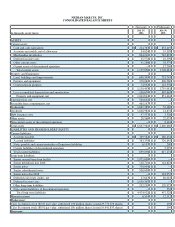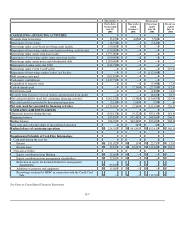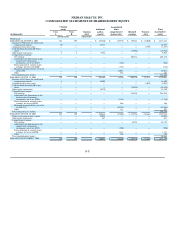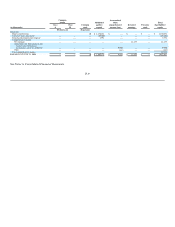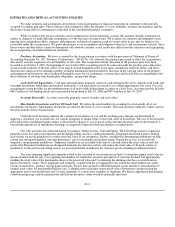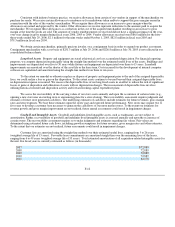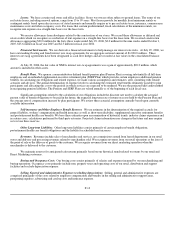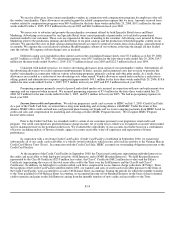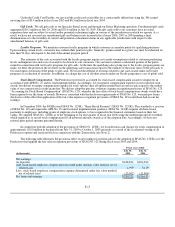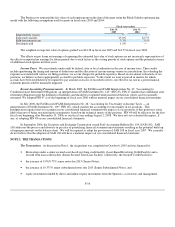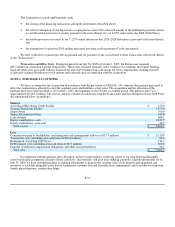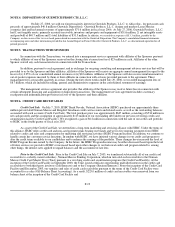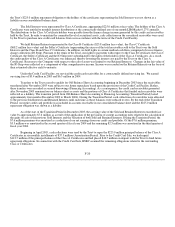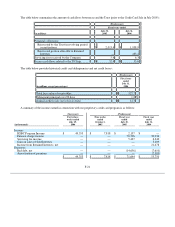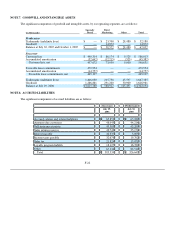Neiman Marcus 2005 Annual Report Download - page 92
Download and view the complete annual report
Please find page 92 of the 2005 Neiman Marcus annual report below. You can navigate through the pages in the report by either clicking on the pages listed below, or by using the keyword search tool below to find specific information within the annual report.
Leases. We lease certain retail stores and office facilities. Stores we own are often subject to ground leases. The terms of our
real estate leases, including renewal options, range from 15 to 99 years. Most leases provide for monthly fixed minimum rentals or
contingent rentals based upon sales in excess of stated amounts and normally require us to pay real estate taxes, insurance, common area
maintenance costs and other occupancy costs. For leases that contain predetermined, fixed calculations of the minimum rentals, we
recognize rent expense on a straight-line basis over the lease term.
We receive allowances from developers related to the construction of our stores. We record these allowances as deferred real
estate credits which we recognize as a reduction of rent expense on a straight-line basis over the lease term. We received construction
allowances aggregating $30.0 million for the forty-three weeks ended July 29, 2006, $2.0 million for the nine weeks ended October 1,
2005, $25.6 million in fiscal year 2005 and $2.3 million in fiscal year 2004.
Financial Instruments. We use derivative financial instruments to help manage our interest rate risks. At July 29, 2006, we
have outstanding floating and fixed interest rate swap agreements for an aggregate notional amount of $1,000.0 million. These
interest rate swap agreements have been designated as cash flow hedges and are recorded at fair value on the consolidated balance
sheets.
At July 29, 2006, the fair value of NMG's interest rate swap agreements was a gain of approximately $20.2 million, which
amount is included in other assets.
Benefit Plans. We sponsor a noncontributory defined benefit pension plan (Pension Plan) covering substantially all full-time
employees and an unfunded supplemental executive retirement plan (SERP Plan) which provides certain employees additional pension
benefits. In calculating our obligations and related expense, we make various assumptions and estimates, after consulting with outside
actuaries and advisors. The annual determination of expense involves calculating the estimated total benefits ultimately payable to plan
participants and allocating this cost to the periods in which services are expected to be rendered. We use the projected unit credit method
in recognizing pension liabilities. The Pension and SERP Plans are valued annually as of the beginning of each fiscal year.
Significant assumptions related to the calculation of our obligations include the discount rate used to calculate the actuarial
present value of benefit obligations to be paid in the future, the expected long-term rate of return on assets held by the Pension Plan and
the average rate of compensation increase by plan participants. We review these actuarial assumptions annually based upon currently
available information.
Self-insurance and Other Employee Benefit Reserves. We use estimates in the determination of the required accruals for
general liability, workers' compensation and health insurance as well as short-term disability, supplemental executive retirement benefits
and postretirement health care benefits. We base these estimates upon an examination of historical trends, industry claims experience and,
in certain cases, calculations performed by third-party actuaries. Projected claims information may change in the future and may require
us to revise these reserves.
Other Long-term Liabilities. Other long-term liabilities consist primarily of certain employee benefit obligations,
postretirement health care benefit obligations and the liability for scheduled rent increases.
Revenues. Revenues include sales of merchandise and services, net commissions earned from leased departments in our retail
stores and delivery and processing revenues related to merchandise sold. We recognize revenues from our retail operations at the later of
the point of sale or the delivery of goods to the customer. We recognize revenues from our direct marketing operation when the
merchandise is delivered to the customer.
We maintain reserves for anticipated sales returns primarily based on our historical trends related to returns by our retail and
Direct Marketing customers.
Buying and Occupancy Costs. Our buying costs consist primarily of salaries and expenses incurred by our merchandising and
buying operations. Occupancy costs primarily include rent, property taxes and operating costs of our retail, distribution and support
facilities and exclude depreciation expense.
Selling, General and Administrative Expenses (excluding depreciation). Selling, general and administrative expenses are
comprised principally of the costs related to employee compensation and benefits in the selling and administrative support areas,
preopening expenses, advertising and catalog costs and insurance expense.
F-13


